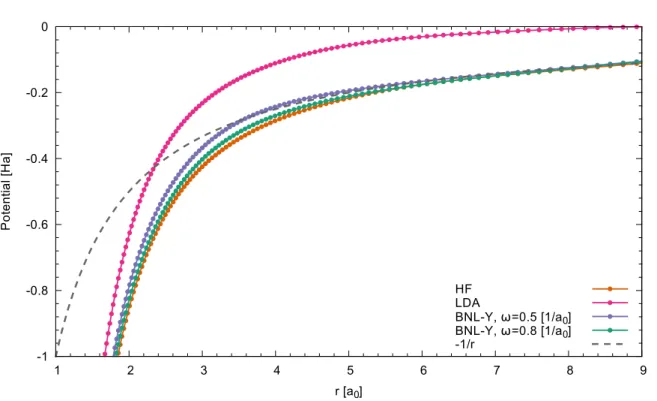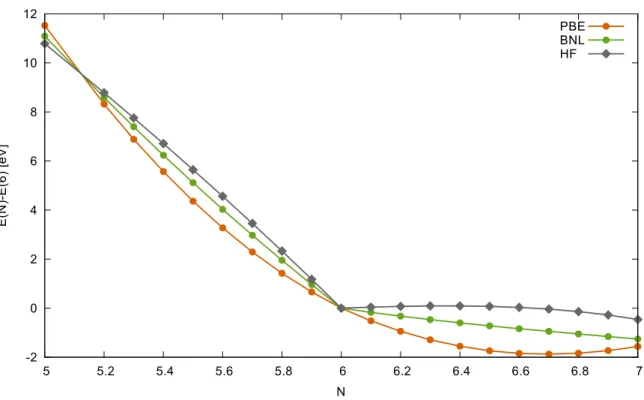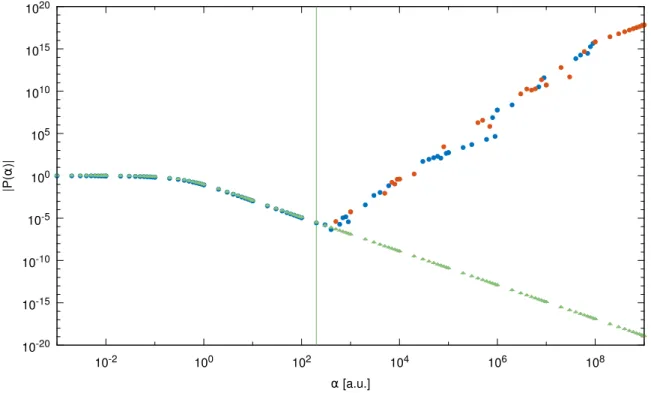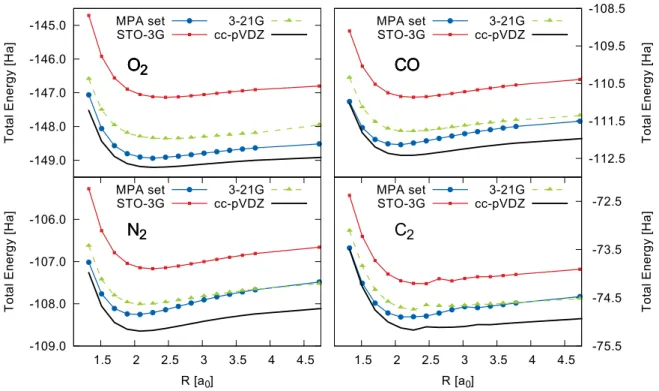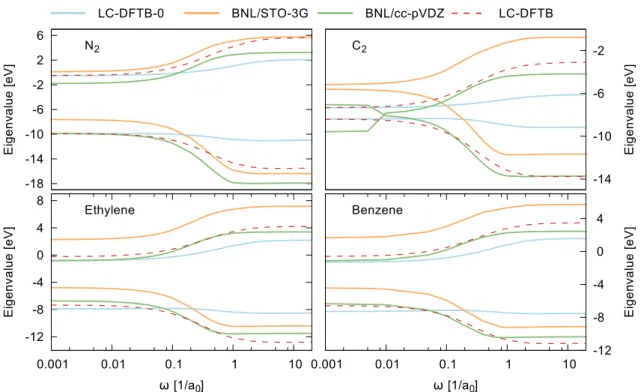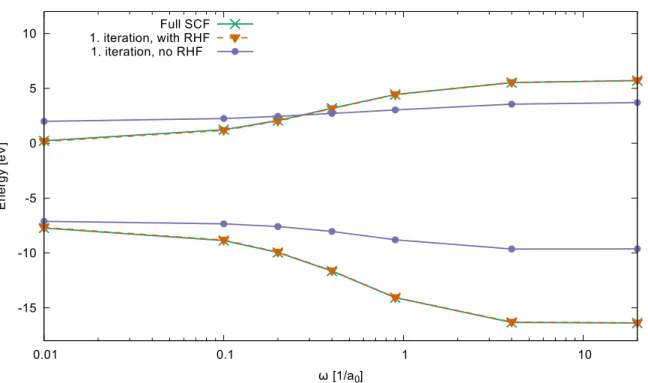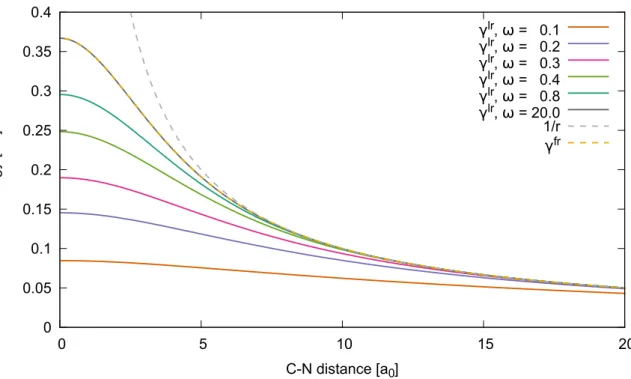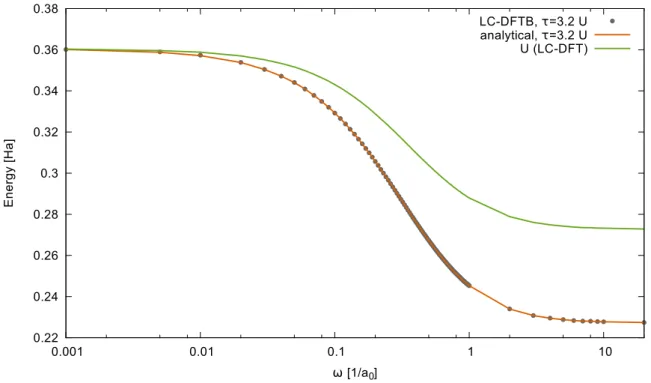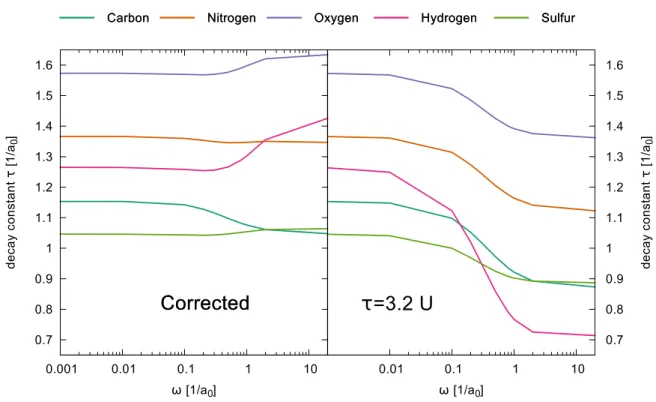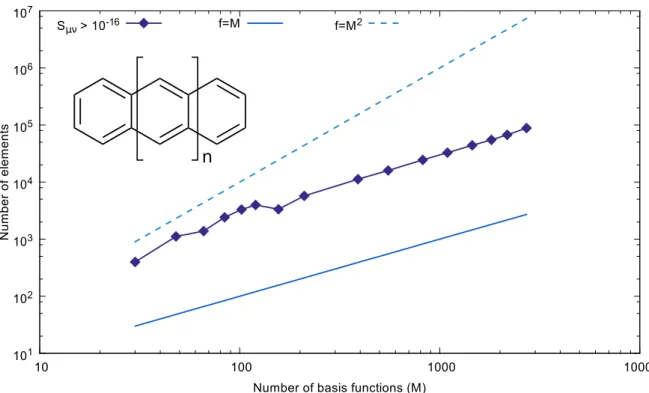Range-Separated Hybrid Functionals in the Density Functional-Based
Tight-Binding Method
Dissertation
zur Erlangung des Doktorgrades der Naturwissenschaften (Dr. rer. nat.)
der Fakultät für Physik der Universität Regensburg
vorgelegt von Vitalij Lutsker aus Ushgorod (Ukraine)
im Jahr 2015
Prüfungsausschuss:
Vorsitzender: Prof. Dr. Jascha Repp 1. Gutachter: Prof. Dr. Thomas Niehaus 2. Gutachter: Prof. Dr. Klaus Richter Weiterer Prüfer: Prof. Dr. Andreas Schäfer
Termin Promotionskolloquium: 23. Juli 2015
T
ABLE OFC
ONTENTSIntroduction v
1 Density functional theory and approximations 1
1.1 Hohenberg-Kohn density functional theory . . . 2
1.2 Practical DFT: the Kohn-Sham approach . . . 3
1.2.1 Local density approximation (LDA) . . . 5
1.2.2 Generalized gradient approximation (GGA) . . . 5
1.3 DFTB: the approximate PBE-based DFT . . . 6
2 Delocalization problem and range-separated hybrid functionals 9 2.1 Self-interaction error . . . 9
2.2 Note on the meaning of the Kohn-Sham eigenvalues . . . 12
2.3 Solution: Hybrid functionals . . . 14
2.3.1 Global hybrids . . . 14
2.3.2 Range-separated functionals . . . 14
2.3.3 Adiabatic connection functional . . . 16
2.4 Matrix equations . . . 17
I Implementation 21 3 LC-DFTB: the approximate LC-DFT 23 3.1 Choice of the xc-functional . . . 23
3.1.1 Correlation functional . . . 24
3.1.2 Short-range exchange functional . . . 25
3.2 Second-order energy expansion . . . 26
3.3 Two-center approximation and the zeroth-order LC-DFTB . . . 28
3.4 Basis set . . . 29
3.4.1 Minimal pseudo-atomic basis set (MPA set) . . . 30
3.4.2 Basis for LC-DFTB . . . 31
3.5 Extension of parametrization tools and computational performance . . . 32
3.6 Eigenvalues from the zeroth-order LC-DFTB . . . 32
3.7 Self-consistent field LC-DFTB . . . 35
3.8 Hubbard parameters . . . 39
3.8.1 Influence of the long-range HF exchange term . . . 40
3.8.2 Comment on the decay constant . . . 43
3.9 Run-time Hamiltonian evaluation . . . 43
3.9.1 Direct SCF and thresholding algorithm . . . 43
3.9.2 Neighbor list-based algorithm . . . 47
3.10 Evaluation of energy gradients . . . 48
4 Evaluation of two-electron integrals 53 4.1 Choice of the integrator . . . 54
4.2 Description of the scheme and extension to Yukawa interaction . . . 54
4.3 Scheme for one-center integrals . . . 58
4.4 Scheme for two-center integrals . . . 61
5 Parametrization of repulsive potentials for hydrocarbons 65 5.1 Why is the new parametrization needed? . . . 65
5.2 Repulsive potential fit procedure . . . 66
5.3 Parametrization and test . . . 68
6 Summary 71 II Applications 75 7 Quasi-particle energies from LC-DFTB 77 7.1 Ionization potentials . . . 78
7.2 Fundamental gaps . . . 81
7.3 Photoemission spectrum . . . 83
7.4 Comment on the choice of the range-separation parameter . . . 86
7.5 Execution times . . . 88
7.6 Summary . . . 90
8 Polymers 91 8.1 Bond length alternation . . . 92
8.2 Emerging polaron signatures . . . 93
8.3 Response to electric field . . . 96
8.4 Proteins in gas-phase . . . 99
8.5 Summary . . . 100
TABLE OF CONTENTS
9 Conclusions and open questions 103
III Appendix 105
A γ-Integral over Yukawa interaction 107
A.1 Reduction to one-dimensional integral . . . 107 A.2 Analytical evaluation of the off-siteγ−integral . . . 108 A.3 Analytical evaluation of the on-siteγ−integral . . . 109
B Average potential 111
C Algorithm for the corrected decay constants 113
D Geometry data for hydrocarbons 115
E Neighbor list-based evaluation of forces 121
Bibliography 123
I
NTRODUCTIONT
he understanding of the electronic structure of atoms, molecules and solids is indispensable for the understanding of the fascinating properties of these physical systems, which justly awaken the interest of both academia and industry. This gives rise to a truly broad spectrum of research activities, including a variety of theoretical approaches. By introducing specific concepts and formalizing them mathematically, the model descriptions arise, which help to deepen the understanding of the condensed matter physics.Remarkably, the exact electronic structure of a many-electron system can be in principle ob- tained from the solution of a boundary value problem with the many-body Schrödinger equation.
This is the starting point for the methods, based on the concept of the wave function. Together with density functional theory (DFT) they constitute the class of first-principles (ab initio) meth- ods, which basically allow to obtainexact description of the electronic structure. In practice, however, the exact solution of many-electron systems from these both approaches is not feasible.
The reasons in both cases, though are different. While the accuracy of the wave-function based methods is in principle limited by the available computational resources, the computationally low priced DFT in it’s Kohn-Sham formulation (KS-DFT) relies on inevitable approximations to the exchange-correlation (xc) energy functional. Thus, what practically really matters is the computational effort to accuracy ratio. The result of which quality can be obtained at a given computational cost? From this point of view, the methods, which allow approximate solutions to the exact problem, but at highly reduced cost become increasingly interesting. The density functional-based tight-binding method (DFTB) is one of such methods, which is derived from a specific KS-DFT with a particular approximate exchange-correlation energy functional by apply- ing a set of approximations. These approximations allow to drastically reduce the computational effort, while keeping the accuracy at acceptable level. The reduction of the computational cost is mainly due to the simple structure of the DFTB equations, which depend on a small set of precomputed parameters.
Usually the exchange-correlation functional in the KS-DFT is modeled within the so called local density approximation (LDA) and it’s generalizations. The simple structure and remarkable accuracy of the exchange-correlation functionals, which emerge from this approach and usually called local functionals, makes them important for practical calculations. However, the KS-DFT with local functionals exhibits systematic failures. This behavior is known as the delocalization problem and is usually connected to the concept of self-interaction error (SIE). In depth investiga-
tion of the delocalization problem resulted in a variety of correction schemes, which successfully deal with it and thus improve the performance of the KS-DFT albeit with moderate increase in computational cost. In particular, the class of range-separated hybrid exchange-correlation functionals deals with the delocalization problem to a great extent. These functionals require the inclusion of a range-dependent Hartree-Fock exchange term, which results in the hybrid Hartree-Fock-DFT calculation.
It is known, that the traditional DFTB, which is derived from the KS-DFT with a local exchange-correlation functional inherits the curse of the delocalization problem [43]. The success of the KS-DFT with range-separated hybrid functionals gives rise to the expectation, that the approximate methods, which are derived from it will be less prone to the delocalization problem.
In ref. [137] the usual DFTB approximations have been formally applied to a DFT with a long- range corrected functional (LC-DFT), which is a special case of a range-separated functional (compare also section 2.3 of this thesis). The legitimacy of such approximations with respect to the new functional has been provided. This is the starting point of the work, presented in this thesis, which is organized as follows.
In chapter 1 we introduce the DFT as initially formulated by Hohenberg and Kohn and it’s formulation as a single-particle theory, given by Kohn and Sham (KS-DFT). We give brief comment on the local density approximation and generalized gradient approximation. We also briefly introduce the traditional DFTB method.
In chapter 2 we discuss the delocalization problem and comment on the hybrid functionals, which are usually able to deal with the delocalization problem. In particular, the definition of the range-separated functionals is given.
The technical part I of this thesis is dedicated to the implementation and parametrization of the new scheme. The specific parametrization, which is used in this thesis is called the long- range corrected DFTB (LC-DFTB). The in depth description of the method, discussion on the choice of the underlying exchange-correlation functional, specific aspects of the parametrization and numerical efficiency of the current run-time implementation are found in chapter 3. The DFTB method by construction relies on a set of precomputed parameters. The modification of parametrization programs is necessary in order to perform the parametrization of the DFTB method with a new functional. We address the aspects of these modifications in chapter 4, where the integration routines for the evaluation of specific two-electron integrals are described. In chapter 5 the parametrization of the repulsive potential, in particular important for the geometry optimization for the elements C and H is described.
In the part II we apply the LC-DFTB method to a series of problems, which are usually insufficiently described by the DFT with local functionals and by traditional DFTB. In chapter 7 for the first time the LC-DFTB method is applied to a series of organic molecules. We discuss the frontier orbital energies as obtained from the new method and compare them to the experimental data (where available), the traditional DFTB method and the first-principles DFT with local
and with long-range corrected functionals. We furthermore discuss the possibility of obtaining photoemission spectra from LC-DFTB. The comparison of computational times of LC-DFTB against first-principles approaches and traditional DFTB is addressed as well. In chapter 8 we apply the LC-DFTB totrans-polyacetylene oligomers and study again quantities, which are problematic for the traditional DFTB method. This includes the difference in single and double bond lengths also known as bond length alternation, response to the electric field (specifically the static longitudinal polarizability) and the formation of polaronic defects in the doped polymer.
Finally, the application of LC-DFTB to the two selected proteins in zwitterionic conformation in gas-phase is performed.
In the appendix, the supplementary information to the chapters of the main text can be found.
In appendix A the analytical formulas for the long-rangeγ−integral, which is important in the new method, are derived. In appendix B the algorithm for the evaluation of the average potential from converged orbitals, which is used for a calculation in chapter 2 is described. This method was initially mentioned in ref. [9]. In appendix C the numerical algorithm for the correction of decay constants (see also section 3.8) is presented. The appendix D accompanies the description of the repulsive potential parametrization in chapter 5 and contains the summary of bond lengths and angles of a benchmark set of selected hydrocarbons as obtained from the LC-DFTB and other methods, compared to experiment. The vibrational frequencies of the reference molecules, used for the parametrization, are presented as well. Finally in appendix E the pseudo code and corresponding equations for the neighbor list-based evaluation of the energy gradients (section 3.10) are presented, which accompany the source code of the implementation in the DFTB+ code [6].
C
HAPTER1
D
ENSITY FUNCTIONAL THEORY AND APPROXIMATIONSI
n quantum theory the central concept is the wave functionΨ. The energy of a physical system is the functional of the wave function and the variational principle holdsE[Ψ]≥E[Ψ0], (1.1)
where the wave functionΨ0represents the ground state and the equality holds forΨ=Ψ0. The wave function is the solution of the stationary Schrödinger boundary value problem
HˆΨ=EΨ. (1.2)
Here ˆHis the Hamilton operator, which can be constructed in an intuitive way from the classical pendants via correspondence principle. For example, aN-electron system in non-relativistic limit and in Born-Oppenheimer approximation is described by the many-body Hamiltonian in the real space representation1
Hˆ = −1 2
N
X
i=1
∇2i
| {z }
Tˆ
+1 2
N
X
i6=j
1
|ri−rj|
| {z }
Vˆee
+
N
X
i=1 M
X
A=1
−ZA
|ri−RA|
| {z }
Vˆext
, (1.3)
whereri is the coordinate of thei−th electron,ZAandRA are the charge and coordinate of the nuclei A. The corresponding wave function Ψ=Ψ(x1,x2, ...,xN) depends on coordinatesxi of thei−th electron, which comprise space coordinatesriand spin coordinatesωi. From the wave function the expectation value of each observable can be obtained. The energy functional is the expectation value of the Hamilton operator, provided〈Ψ|Ψ〉 =1
E[Ψ]= 〈Ψ|Hˆ|Ψ〉 = 〈Ψ|Tˆ|Ψ〉 + 〈Ψ|Vˆee|Ψ〉 + 〈Ψ|Vˆext|Ψ〉 =T[Ψ]+Vee[Ψ]+ Z
ρ(r)vext(r)dr. (1.4)
1in this thesis we use atomic units if not stated otherwise.
Note, that the expectation value of the kinetic energy operatorT[Ψ]= 〈Ψ|Tˆ|Ψ〉and the electron- electron interaction energy operatorVee[Ψ]= 〈Ψ|Vˆee|Ψ〉depend only on the number of electrons N. The variational principle, the particle numberN and the external potential determine the ground state wave function.
This approach to the exact description of many-electron systems like atoms or molecules, however, turns out to be problematic in practice. For large electron numbers it faces, what W.
Kohn calls the exponential wall [97]. The effort to store and construct an accurate approximation to the exact wave function, as well as to minimize the corresponding energy functional grows exponentially for increasing system size. Thus usually different levels of approximations are introduced. One of the most famous in this context is the Hartree-Fock (HF) approximation. For a given many-body Hamiltonian it is the wave function which is approximated. One assumes that the system is described by an antisymmetric product of single-particle wave functions (Slater determinant). The HF approximation results in the theory which includes the classical electron repulsion and quantum mechanical Pauli-principle. However, the purely quantum mechanical electron-electron repulsion, known as correlation energy, is not included in the HF theory.2Nevertheless, it is the starting point for the correlated wave function-based methods, generally called post-Hartree-Fock methods. This includes the configuration interaction (CI) [181], perturbation theory (MP2) [128], Hedin approximation (GW) [7, 66] and coupled cluster (CC) [130] methods. Despite their success and high accuracy these methods still have tremendous computational demands. They are not practicable for extended systems. In fact their high computational requirements are still related to the fact, that the approximate representation of a highly complex exact wave-function beyond single Slater determinant is exploited. The alternative approach due to Hohenberg and Kohn is described in following.
1.1 HOHENBERG-KOHN DENSITY FUNCTIONAL THEORY
As has been already stated in the wave function-based methods the knowledge of the wave function implies knowledge over every observable of the system in the corresponding state. So, for example the density of a system, which can be directly measured, is obtained from the wave function according to
ρ(r1)=N Z
|Ψ(x1,x2, ...xN)|2dω1dx2...dxN. (1.5) Hohenberg and Kohn asked, whether the knowledge of the ground state density implies knowl- edge over every observable in the ground state? With other words, does the density uniquely de- termine the ground state of a physical system? They showed, that the description of aN−electron system by a wave function and corresponding Schrödinger equation can be replaced by an equivalent theory, based on the electronic density [72].
2The correlation energyEcis often defined as the difference of exact and Hartree-Fock energies.
1.2. PRACTICAL DFT: THE KOHN-SHAM APPROACH
The theory is based on two theorems. The first one states: The external potentialvext(r) is determined by the ground state electron densityρ0(r) up to a trivial additive constant. Thus a ground state density, which yieldsN=R
ρ(r)drdetermines the wave function and thus all ground state properties of anN−electron system. The proof of the theorem can be found in ref.
[72]. The total energy of the system is the functional of density E[ρ]=F[ρ]+
Z
ρ(r)vext(r)dr, (1.6)
where the functionalF[ρ]=T[ρ]+Vee[ρ] is composed of kinetic and electron interaction energies, which itself are functionals of density. This functional is called the universal functional for a
N−electron system, since it does not depend on the external potential. The second theorem constitutes the variational principle. Given a densityρ0 and the ground state densityρ0, for the fixed external potential the energy functional obeys the inequality
E[ρ0]≥E[ρ0], (1.7)
where the equality holds for the caseρ0=ρ0. Thus, ground state energy and the corresponding density can be obtained from
δ
½
E[ρ]−µZ
ρ(r)dr
¾
=0 (1.8)
with some Lagrange multiplierµ, which is characteristic to the system and can be identified as the chemical potential of the system [148]. In this case the density corresponds to the global minimum of the energy functional.
The simplicity of the Hohenberg-Kohn theory faces a serious challenge, which is still not overcome. The explicit form of the universal functional is not known and is suspected to be complicated. In this respect the universal functional plays the role of the exact wave function in the wave function-based methods.
In following we present the approach due to Kohn and Sham [98]. They show an elegant way how to relate an effective single particle theory to the Hohenberg-Kohn theory. The “unknown and complicated” in their approach is placed into a small part of the universal energy functional, while the rest is treated on the same footing as in the wave function-based single particle theory (like HF). Despite it’s single particle form, it is exact.
1.2 PRACTICAL DFT:THE KOHN-SHAM APPROACH
We now show how to come from the Hohenberg-Kohn energy functional to a practical scheme.
The Hohenberg-Kohn energy functional can be defined in the following way [111, 112]
E[ρ]=min
Ψ→ρ〈Ψ|Tˆ+Vˆee|Ψ〉
| {z }
F[ρ]
+ Z
ρ(r)vext(r)dr, (1.9)
where theF[ρ] is the universal functional, which depends only on the number of particles. Here the notationΨ→ρmeans that the minimization process runs over all valid many-body wave functions, which yield the density ρ. The universal functional is not known. The idea is to represent the functional by some known model, which contributes the most to the energy and the rest, which is then approximated. The universal functional for a non-interacting fermionic system is
F0[ρ]=min
Φ→ρ〈Φ|Tˆ|Φ〉 =T0[ρ], (1.10) where the wave functionΦ= |φ1φ2...φN|is the Slater determinant. The density can be expressed in terms of the single-particle orbitalsρ(r)=
N
P
i |φi(r)|2. The key point in this procedure is that the minimization is performed over the Slater determinants, which yield the same density as the interacting wave functions in Eq. 1.9. For more detailed discussion of the foundations of the Hohenberg-Kohn DFT and Kohn-Sham DFT (KS-DFT) we refer to ref. [143]. The energy is then expressed in terms of classical Coulomb interaction (Hartree term)EH[ρ]=R ρ(r)ρ(r0)
|r−r0| drdr0, the non-interacting kinetic energyT0=P
i
Rφi(r)(−12∇2)φi(r)dr, the energy due to the interaction with the external potentialvext(r) and the rest, which is referred to as the exchange-correlation (xc) energyExc
E[ρ]=T0[ρ]+EH[ρ]+ Z
vext(r)ρ(r)dr+Exc[ρ]. (1.11) TheExc accounts for quantum mechanical electron-electron interaction effects. We rewrite the universal energy functional
F[ρ]=T0[ρ]+EH[ρ]+£
T[ρ]+V[ρ]−T0[ρ]−EH[ρ]¤
| {z }
Exc[ρ]
, (1.12)
where the last term defines the exchange-correlation functional. The minimization due to the density in Eq. 1.8 can be replaced by an equivalent minimization due to a set of orbitals, which constitute a Slater determinant. This gives the set ofN Kohn-Sham equations
µ
−1
2∇2+vKS(r)
¶
φi(r)=²iφi(r) (1.13)
with a local effective Kohn-Sham potential vKS(r)=vext(r)+
Z ρ(r0)
|r−r0|dr0+vxc(r), (1.14) where the exchange-correlation potential is defined as the functional derivative of the exchange- correlation energy vxc(r)= δδρExc. Thus the interacting system can be mapped onto the non- interacting with modified local effective potential. We again emphasize, that the KS-DFT is by construction exact. However, in practice the unknown exchange-correlation functional has still to be approximated. These approximations lead to some spectacular failures of DFT, which we will discuss in chapter 2.
1.2. PRACTICAL DFT: THE KOHN-SHAM APPROACH
1.2.1 Local density approximation (LDA)
Kohn and Sham proposed a simple approximate form of the exchange-correlation functional, expressed in terms of densityρ(r) and exchange-correlation energy density per particle²LDAxc (r) of an uniform electron gas with densityρ
ELDAxc = Z
²LDAxc [ρ](r)ρ(r)dr. (1.15) The latter is split into exchange and correlation parts,
²LDAxc [ρ](r)=²LDAx [ρ](r)+²LDAc [ρ](r). (1.16) The exchange part is given by the Slater formula for uniform electron gas
²LDAx [ρ](r)= −3 4
µ3ρ(r) π
¶1/3
. (1.17)
The explicit expression for the correlation part²LDAc [ρ](r) is not known. Instead it is parametrized from the available numerical quantum Monte-Carlo data [30].
1.2.2 Generalized gradient approximation (GGA)
While the LDA functionals depend only on the density at the evaluation point, the generalized gradient approximation functionals use the information about the density behavior around the evaluation point. This is done by introducing the explicit dependence on the density gradients in addition to the density. This additional information leads to a significant qualitative improvement over the LDA functionals in terms of atomization energies, exchange and correlation energies, reaction barriers. The GGA functionals are usually formulated as the extended LDA functional
EGGAxc = Z
ρ(r)²LDAxc [ρ](r)F(s)dr (1.18) with the GGA enhancement factor F(s), which depends on the reduced density gradient s=
|∇ρ|ρ 1
2(3π2ρ)1/3. The GGA functionals in general outperform the LDA functionals (see for example refs. [1, 34, 106]).
The methods, presented in this thesis have been developed based on the LDA functional and GGA functional of Perdew, Burke and Ernzerhof (PBE) [146]. The latter is defined for the case of spin unpolarized system as
EPBEx = Z
ρ(r)²LDAx (r)
·
1+κ− κ 1+(µ/κ)s2
¸
dr (1.19)
EPBEc = Z
ρ(r)
·
²LDAc (r)+γln µ
1+βγ t2+At4 1+At2+A2t4
¶¸
dr, (1.20)
where the constantsµ=0.21951,κ=0.804,β=0.066725,γ=0.031091 appear andt= |∇ρ|(2ksρ)−1, ks=q4k
πaF0,kF=(3π2ρ)1/3and A=βγ£ exp¡
−²LDAc /(γe2/a0)¢
−1¤−1
. The functional is developed to fulfill a set of exact conditions of the exchange-correlation functional and contains no empirical parameters.
1.3 DFTB: THE APPROXIMATEPBE-BASED DFT
The Kohn-Sham method is implemented in nearly every general purpose quantum chemistry program package. The program packages use highly optimized algorithms which are the result of a half a century of intensive scientific research. Still, the applicability of the Kohn-Sham DFT, dependent on the desired information extent and it’s precision (provided we are interested in qualitatively meaningful results), is restricted to the systems up to a several hundreds of atoms in size. In order to access the systems which are well beyond the computational limits of the DFT at the given moment of time the approximate methods are developed.
In following we introduce the method, which can be classified as an approximate Kohn-Sham DFT, the density functional-based tight-binding method (DFTB) [42, 46, 155, 175]. Formally it is similar to the empirical tight-binding schemes [56, 76], but in contrast to these it is derived from the DFT with LDA or GGA xc-functional. Thus in fact it is the approximated DFT, rather than a model, parametrized from empirical data.
The DFTB approximations lead to the energy, which is formulated in terms of two-center parameters, which depend on the interatomic distanceRAB
E=
occ
X
i basis
X
µν
cµicνiHµν0 (RAB)+1 2
atoms
X
AB
γAB(RAB)∆qA∆qB+1 2
atoms
X
AB
VAB(RAB). (1.21) The coefficients cµirepresent the molecular Kohn-Sham orbitalψi, which is approximated by a linear combination of atom-centered functionsφµ(LCAO ansatz)
ψi(r)=
basis
X
µ
cµiφµ(r). (1.22)
These functions are orthogonal on each atom, but not orthogonal if they are on distinct atoms.
Their overlap integral is denoted bySµν=R
φµ(r)φν(r)dr. The molecular orbital (MO) coefficients cµiare obtained by solving the generalized eigenvalue problem
X
ν
Ã
H0µν+1 2Sµν
atoms
X
C
(γAC+γBC)∆qC
! cνi=²i
X
ν
Sµνcνi, (1.23) which can be derived by applying the variational principle to the DFTB energy expression with respect to the MO coefficients. Here the Mulliken atomic charges are defined as
∆qA=1 2
X
µ∈A
X
ν occ
X
i
¡cµicνiSµν+cνicµiSνµ¢
−q0A, (1.24)
where q0A is the number of valence electrons of the atom A. The parametersγAB for the case A6=Bare parametrized as [42]
γAB(R)= 1 R−
"
e−τAR
à τ4BτA
2(τ2A−τ2B)2− τ
6
B−3τ4Bτ2A (τ2A−τ2B)3R
!
+e−τBR
à τ4AτB
2(τ2B−τ2A)2−τ
6
A−3τ4Aτ2B (τ2B−τ2A)3R
!#
, (1.25)
1.3. DFTB: THE APPROXIMATE PBE-BASED DFT
where the parameter τA is obtained from the condition that the Hubbard derivativeU for a single atomAcalculated from the reference DFT-PBE calculation should be equal to the Hubbard parameter, obtained from the DFTB calculation
U=∂
2Eatom,PBE
∂n2
=! ∂
2Eatom,DFTB
∂∆q2 =γAA= 5
16τA, (1.26)
where γAA is the on-siteγ−parameter and the derivative ∂2Eatom,PBE∂n2 is performed numerically with respect to the occupation numbernof the highest occupied molecular orbital (HOMO). For the DFTB the Hubbard derivative is known analytically and equals to the on-siteγ−parameter γA A=165τA. The distance dependentγ-parameters represent the approximated electron repulsion integrals and effectively contain the contributions due to the exchange-correlation potential. The zeroth-order HamiltonianH0µνis defined as
H0µν=
²free atomµ µ=ν
〈φµ|HDFT-PBE[ρA+ρB]|φν〉 µ∈A,ν∈B
0 else,
(1.27)
where²free atomµ is the eigenvalue of a spherically symmetric free pseudo-atom, obtained from the DFT-PBE calculation, andHDFT-PBE[ρA+ρB] is the DFT-PBE Hamiltonian evaluated at the reference densityρ=ρA+ρB, which is a simple superposition of atomic densitiesρA,ρB. Finally, the repulsive pair-potentialsVABfor a pair of atomic species are obtained by a fit to the total energies of a reference DFT method.
The DFTB method operates with precomputed parameters and simple analytical formulas.
These quantities, apart from the repulsive potential, are directly connected to the quantities in KS-DFT, which is being approximated by the DFTB. This will become more evident in chapter 3, where we derive the DFTB method as an approximation of a long-range corrected hybrid DFT (section 2.3), which contains the PBE-based DFTB (standard DFTB) as a special case. Together with small number of basis functions per atom the efficient large scale calculations (≈10000 atoms) are possible. This opens the possibility to study large biological systems, perform the potential energy scans, do the molecular dynamics simulations for both extended systems and large time scales [35, 42, 43, 50].
C
HAPTER2
D
ELOCALIZATION PROBLEM AND RANGE-
SEPARATED HYBRID FUNCTIONALST
he GGA and LDA functionals, mentioned in previous chapter have an excellent accuracy to computational cost ratio and are usually easy to implement. They depend on the density and it’s gradients in an explicit way and usually called local or semilocal functionals. However, the DFT with this class of exchange-correlation functionals exhibits remarkable failures. Incorrect dissociation limits of molecules [11, 205], instability of anions [184, 199], absence of Rydberg series [9], underestimation of reaction barriers [34], overestimation of the electric field response [196, 205], generally bad description of localized states [45, 192] are often mentioned in this context. The approximations to the DFT with local xc-functionals, such as the DFTB method (section 1.3) inherit this erroneous behavior [77, 118, 137, 158].2.1 SELF-INTERACTION ERROR
The aforementioned failures have a common root: the inability of the DFT with local xc-functionals to deal with the self-interaction error (SIE), also known as delocalization problem. The standard illustration of this behavior is the dissociation of a H+2 molecule ion [11]. Local DFT predicts two protons at infinite separation with half an electron around each of them. The self-interaction of the only electron, which is by construction included in the Hartree energy should be cancelled by the exact exchange-correlation energy. In the HF-theory it is the case and the dissociation limit is correct. The approximate form of the xc-functional in the local DFT, however, gives rise to spurious, unphysical self-interaction. Extending this reasoning to the systems with many electrons the functional is called one-electron self-interaction free, if it fulfills the condition
Exc[ρi]+EH[ρi]=0, (2.1)
-1 -0.8 -0.6 -0.4 -0.2 0
1 2 3 4 5 6 7 8 9
Potential [Ha]
r [a0]
HFLDA
BNL-Y, ω=0.5 [1/a0] BNL-Y, ω=0.8 [1/a0] -1/r
Figure 2.1: The LDA potential and averaged HF and BNL-Y (section 3.1) potentials for a single argon atom as a function of distance from nuclei. The gray dashed line indicates the correct−1/r limit.
whereρi= |ψi|2is the one-electron density [150]. It is in general expected, that the self-interaction error should be connected to the properties of the xc-potential. For example, physically it is expected, that an electron of a finite charge-neutral system, if removed to infinity (the system is ionized), interacts with the hole, which is created in this electron removal process. This implies, that the potential, which is seen by the electron should exhibit the−1/rasymptotics [3]
lim
|r|→∞vxc(r)= − 1
|r|. (2.2)
In Fig. 2.1 the LDA potential of an argon atom as a function of distance from nucleus is depicted.
It decays exponentially, much faster than the correct −1/r limit, indicated here by the gray dashed line. On contrast, the average potentials from the Hartree-Fock theory and the long-range corrected functional BNL-Y, which will be introduced in section 3.1 show correct long-range behavior. The potentials have been obtained according to the procedure, suggested in ref. [9] and the details of the calculation can be found in appendix B. The correct asymptotic decay of the xc-potential is an important condition for the improvement of the theory [9, 14, 29, 193].
It has been found, however, that the functionals, which are one-electron self-interaction free, in the case of many-electron systems can still exhibit failures, related to the self-interaction error [17, 34, 131]. While the concept of one-electron self-interaction error is simple from the physical point, it is not the best choice to understand and mathematically formalize the self-interaction
2.1. SELF-INTERACTION ERROR
-2 0 2 4 6 8 10 12
5 5.2 5.4 5.6 5.8 6 6.2 6.4 6.6 6.8 7
E(N)-E(6) [eV]
N
PBE BNL HF
Figure 2.2: Total energy of a carbon atom as a function of electron numberNfor DFT with local PBE and long-range corrected BNL functionals and HF theory. Calculations have been performed with NWCHEM package [195] in spin unrestricted formalism with aug-cc-pVDZ basis set. The number of up-electrons was varied from 3 to 5, while number of down-electrons was kept equal 2.
Note, that the curves have been shifted such thatE(6)=0 for each method.
error in many-electron systems. Another approach to this problem can be made by considering fractionally occupied systems. While such systems are not physical, their study gives deeper insights into the delocalization problem and allows to formulate conditions for the functional design. The main result in this respect has been provided by Perdew et al. [148]. They showed that the ground-state energy of a statistical mixture of anN-electron pure stateΨN with an (N+1)-electron pure stateΨN+1 with corresponding densityρ(r)=(1−ω)ρN(r)+ωρN+1(r) is given by
E=(1−ω)EN+ωEN+1. (2.3)
HereENandEN+1are the ground state energies of theNand (N+1)−particle system respectively and 0≤ω≤1. This mixture is then a (N+ω)-particle system. The exact ground state energy as a function of fractional occupation is piece-wise linear. It is linear between two adjacent integer particle numbers and exhibits jumps in the derivative at integer occupations. In Fig. 2.2 an example calculation for a carbon atom is carried out. The total energy of a fractionally occupied carbon atom as a function of electron numberN for the local PBE functional [146], the HF theory and the long-range corrected BNL functional [10, 116] are plotted. The curves have been shifted
such that the energy of a neutral carbon with number of electronsN=6 for each theory is at 0. We clearly observe the non-linear behavior for PBE and HF theories. The local DFT gives usually good estimates to the ground state energies of systems with integer particle numbers.
However, fractionally occupied systems have too low energies and thus are favoured by the local DFT. This is the reason for the wrong dissociation of the H+2 ion. The energy of two infinitely separated fractionally occupied H0.5+atoms is lower than the energy of the H++ H system. One could also say, that the local DFT tends to overly delocalize the density. At the same time the HF theory gives too high energies for fractionally occupied systems [58, 149, 205]. For the molecule dissociation this is not so crucial, since the integer occupations are favoured. The HF shows tendency to overly localize the density.
From the relation between the energy derivative with respect to the occupationniof a single particle Kohn-Sham (KS) orbital and the energy of this orbital²i
∂Etotal
∂ni =²i, (2.4)
also known as Janak’s theorem, one can identify the highest occupied molecular orbital (HOMO) as the chemical potential of the system [87, 150]. The negative of the HOMO eigenvalue from the exact KS-theory equals to the ionization potential (IP) of the system. Indeed from Fig. 2.2 we see that the slope of the energy curve atN=6 from the left derivative is too low for the local DFT and too high for the HF theory if compared to the assumed linear behavior (we assume that the energies for integer particle numbers are correct). This means, that the HOMO eigenvalue from PBE underestimates the IP and the HF in contrast overestimates it. It has been observed, that for many cases, where the local DFT systematically underestimates a quantity, the HF overestimates it (and vice versa). For example the bond-length alternation in the conjugated polymer chains is overestimated by the HF theory, while the local DFT usually underestimate it (compare also results of section 8.1 in this thesis). The long-range corrected (range-separated) functionals, like BNL show almost linear energy dependence on fractional charge and have balanced behavior.
They usually outperform both, local DFT and HF in cases, where delocalization problem gives rise to massive errors.
The currently accepted definition of the self-interaction free functional is the one which fulfills the linearity condition [34]. For this reason the condition−²HOMO=IP is an important indicator for the correction of the self-interaction error.
2.2 NOTE ON THE MEANING OF THE KOHN-SHAM EIGENVALUES
By construction the KS-eigenvalues do not have any physical meaning, with HOMO eigenvalue being an important exception. Despite this fact the connection between the Kohn-Sham HOMO- LUMO gap (EKSgap=²LUMO−²HOMO) and experimental gaps has been extensively studied [86, 101, 169, 203]. Surprisingly it has been found, that the optical gap in some cases is very accurately described by the HOMO-LUMO gap from hybrid functionals like B3LYP [101, 168, 169, 203].
2.2. NOTE ON THE MEANING OF THE KOHN-SHAM EIGENVALUES
Studies on different systems, however, reveal that such findings are rather fortuitous [80, 86, 132, 172, 189]. Thus in general there is no evident correlation between the band gap and the HOMO-LUMO gap. The interpretation is based on a misconception.
Physically there are two distinct experimentally accessible gaps. The fundamental gap is the difference of the ionization potential (IP) and the electron affinity (EA). Experimentally it can be determined by measuring both quantities separately using photoemission spectroscopy (ionization potential) and inverse photoemission spectroscopy (electron affinity). Both processes are particle addition/removal processes, thus the particle number is not conserved. Such a process can not be described by a single ground state DFT calculation. However, it can be described by two ground state calculations, for example one for theN- and another for the (N+1)-particle systems. Using the Janak’s theorem, provided the functional is exact, theN-particle calculation gives the IP and the (N+1)-particle calculation the EA. The proper fundamental gap from the KS-theory is
Egap=IP−EA=EKSgap+∆xc, (2.5) where the first term is the HOMO-LUMO gap from the KS-calculation and∆xc is the derivative discontinuity [113]. The latter can be evaluated only from two distinct ground state calculations with different particle numbers. For example for range-separated (long-range corrected) func- tionals (section 2.3.2) the derivative discontinuity is equal to the difference of the HOMO for the (N+1)-system and LUMO of theN-system [9]. For this reason a single ground state calculation will give an exact IP but the EA from LUMO eigenvalue will be in general wrong. Nevertheless, practical calculations show, that HOMO-LUMO gaps from nearly SIE-free functionals (e.g. range- separated functionals, sections 2.3.2 and 2.3.3) compare very well to experimental fundamental gaps [103].
The optical gap is defined as the difference of the lowest dipole-allowed excited state and the ground state. It can be measured by absorption spectroscopy. In this process the number of electrons is unchanged. It can be thought of as the creation of quasi-electron and quasi-hole. The interaction energy of these particles (binding energy of the exciton) leads to the optical gap which is smaller than the fundamental gap. The optical gap can be obtained in a proper way only using the time-dependent DFT [167], which is beyond the scope of this work. The local functionals, however, violating the linearity condition underestimate the IP and in the same way the EA (calculated from LUMO eigenvalue). Thus statistically they can yield a good estimate of the optical gaps as has been stated above.
Finally, we point out, that according to the Görling-Levy perturbation theory [57, 113], the physical foundation to the occupied KS-eigenvalues can be given. The KS-eigenvalue differences, have been shown to be the approximations to the excitation energies of the zeroth order in electron-electron interaction. Thus it can be expected, that the single-particle eigenvalues can be good estimates to the vertical IP’s of the system, as measured by photoemission experiments. In fact, the references [33, 194] provide the evidence for this assumption.
2.3 SOLUTION: HYBRID FUNCTIONALS
2.3.1 Global hybrids
Hartree-Fock theory or the exact exchange functional in the KS theory (EXX) correct the self- interaction error, which stems from Hartree term in the exact manner. However, these functionals do not contain the correlation. On contrast, local approximate xc-functionals employ the exchange and correlation in a consistent way and take the advantage of mutual error cancellation of the exchange and correlation contributions. The combination of the two theories is usually referred to as a (global) hybrid Hartree-Fock-DFT theory or (global) hybrid xc-functionals. A fixed fraction αof the exact exchange is mixed to the usual DFT functional
Ehybridxc =EDFTxc +α(EHFx −EDFTx ). (2.6) The mixing parameterαcan be determined empirically [16] or using the adiabatic connection theorem [147]. The HF exchange functional is explicitly orbital dependent. This leads to the problem, that the KS-potential Eq. 1.14 can not be obtained by explicit differentiation of the exact exchange with respect to the density. This problem can be solved with optimized effective potential (OEP) approach [105, 179, 191]. This procedure gives the KS-potential which corresponds to the orbitals, which minimize the total energy of the orbital-dependent functional. However, this approach is computationally very costly and is rarely used in practical calculations on extended systems.
An alternative way of employing the hybrid functionals, which is widely used in practical calculations is the generalized Kohn-Sham (GKS) approach. Instead of mapping the interacting system to the fully non-interacting, like in the pure Kohn-Sham approach, Seidl et. al. proposed to map the interacting system to an interacting one, which can be still described by a single Slater determinant (for example HF theory) [174]. This is the formal basis for the hybrid HF-DFT methods. Practically, the calculations are performed as in HF theory with additional local DFT potential.
The hybrid functionals correct many failures of local functionals and usually give very accurate results for a wide range of properties. However, they do not completely remove the self-interaction error.
2.3.2 Range-separated functionals
The asymptotic decay of the potential from the global hybrid functionals is−α/r, i.e. proportional to the fraction of the exact exchange. To obtain the correct asymptotic decay of the potential the functionals have been proposed, which include the exact HF exchange for the long-range interaction and employ the local DFT exchange for the short-range interaction. This is achieved
2.3. SOLUTION: HYBRID FUNCTIONALS
by partitioning of the electron-electron interaction 1
r=ξ
ωsr(r) r
| {z }
DF T
+1−ξωsr(r) r
| {z }
HF
(2.7)
by some smooth range-separation functionξωsr(r). It is usually chosen to be a complementary error functionξωsr(r)=1−erf(ωr) or exponential functionξωsr(r)=e−ωr. In the latter case the screened Coulomb potential is of Yukawa type, thus we refer to it as Yukawa screening. The particular form of the range-separation function turns out to be of minor importance for the scheme. The long-range HF exchange then enforces the correct asymptotic decay of the xc-potential, while the theory still benefits from mutual error cancellation of the local exchange and correlation functionals at the short range. These functionals are called long-range corrected (LC) functionals.
1The more general form of such functionals, also known as Coulomb-attenuating method (CAM) functionals reads
1
r=1−α−β¡
1−ξωsr(r)¢ r
| {z }
DF T
+α+β¡
1−ξωsr(r)¢ r
| {z }
HF
, (2.8)
where α is the fraction of the global exact HF exchange and α+βis the fraction of the HF exchange for the long-range [2, 200]. The α and β parameters should satisfy the relations 0≤α+β≤1, 0≤α≤1, 0≤β≤1. The xc-energy of such functional can be written as
ECAMxc =£
1−(α+β)¤
EDFTx +αEHFx +β(Eωx,sr,DFT+Eωx,lr,HF)+EDFTc , (2.9) whereEωx,sr,DFTis the short-range exchange functional in LDA or GGA approximation, where the Coulomb interaction is screened by a range-separation function andEωx,lr,HFis the accompanying long-range HF exchange with descreened Coulomb interaction (1−ξωsr(r))/r. This way of mixing the DFT and HF naturally includes different range-separated and global hybrid functionals as limiting cases [2, 53, 54, 163, 198, 200]. The long-range corrected functional is for example obtained forβ=1,α=0, while a global hybrid is obtained forα6=0,β=0.
The parameters in the CAM functionals are essentially determined in an empirical way. As in the case of global hybrids, usual procedure in obtaining the parameters for such functionals is the fit of a standard benchmark set of molecules to experimental thermochemical data. The parametersα,β,ω, obtained in this way are then used for all systems.
The range-separated functionals have been shown to fulfill the linearity condition to a great extent [99]. They generally improve over the local and global hybrid functionals in description of response properties [70, 90, 176], photoemission spectra [99, 161], bond length alternation in conjugated polymers [100] to name some examples.
1Note also, that terms range-separated and long-range corrected are often used as synonyms.
2.3.3 Adiabatic connection functional
The range-separated functionals and the long-range corrected functionals as their special case have been so far introduced on rather empirical grounds. However, they can be directly derived using adiabatic connection theorem. Assume there exists a one-parameter smooth representation of an electron-electron interaction ˆV→Vˆω,a≤ω≤bsuch that ˆVa=0 and ˆVb=Vˆ. The universal functional for the system with such interaction reads
Fω[ρ]= min
Ψω→ρ〈Ψω|Tˆ+Vˆω|Ψω〉. (2.10) Then by constructionFa=T0andFb=F and the xc-functional can be written as
Exc[ρ]= Z b
a
dFω0
dω0 dω0−EH[ρ]. (2.11)
This is known as adiabatic connection theorem [60, 107, 201]. It can be used to derive a long-range corrected functional. Assume the following parametrization of the electron-electron interaction Vˆω=12PN
i6=j
¡1−exp(−ω|ri−rj|¢
|ri−rj|−1. The conditions above are fulfilled fora=0,b→ ∞and the exchange-correlation energy yields
Exc[ρ]= Z ∞
0
dFω0
dω0 dω0−EH[ρ]= Z ∞
0 〈Ψω0|dVˆω0
dω0 |Ψω0〉dω0−EH[ρ]. (2.12) This kind of adiabatic connection along with the practical approximations, which we present below has been suggested by Baer and Neuhauser [10]. To approximately evaluate the adiabatic connection integral they proceed as follows. Given the value of parameterω, the wave function in Eq. 2.12 for the caseω0<ωis assumed to be the Slater determinantΦand forω0>ωthe full interacting wave functionΨ
Z ∞
0 〈Ψω0|dVˆω0
dω0 |Ψω0〉dω0≈ Z ω
0 〈Φ|dVˆω0
dω0 |Φ〉dω0+ Z ∞
ω 〈Ψ|dVˆω0
dω0 |Ψ〉dω0
= 〈Φ|Vˆω|Φ〉 + 〈Ψ|Vˆ−Vˆω|Ψ〉
=1 2
Z 1−e−ω|r−r0|
|r−r0| ρ(r)ρ(r0)drdr0
| {z }
EωH[ρ]
−1 2
Z 1−e−ω|r−r0|
|r−r0| ρ
2(r,r0)drdr0
| {z }
Eω,HFx,lr [ρ]
+ 〈Ψ|Vˆ −Vˆω|Ψ〉, (2.13)
whereρ(r,r0) is the first-order reduced density matrix. The integral is evaluated as Z b
a 〈Ψ|dVˆω0
dω0 |Ψ〉dω0= 〈Ψ|Z b a
dVˆω0
dω0 dω0|Ψ〉 = 〈Ψ|1 2
N
X
i6=j
µ
−e−ω|ri−rj|
|ri−rj|
¶ ¯
¯
¯
¯
b
a
|Ψ〉. (2.14)
The Slater determinantΦ, applied to the descreened interaction operator gives the long-range Hartree term EωH and the long-range Fock term Eωx,lr,HF. With this the Baer-Neuhauser (BN)
2.4. MATRIX EQUATIONS
exchange-correlation functional can be written as
EBNxc [ρ]=Eωx,lr,HF[ρ]+ 〈Ψ|Vˆ−Vˆω|Ψ〉 −EH[ρ]+EωH[ρ]
=Eωx,lr,HF[ρ]+
"
〈Ψ|Vˆ−Vˆω|Ψ〉 −1 2
Z e−ω|r−r0|
|r−r0| ρ(r)ρ(r0)d3rd3r0
#
| {z }
Eωxc
. (2.15)
The long-range HF exchangeEωx,lr,HFis non-local and accompanies the Hartree term in the total energy expression Eq. 1.11 at large separations, correcting the potential asymptotically. The screened part is further approximated as a local DFT functional
Eωxc[ρ]≈ Z
²ωxc[ρ](r)ρ(r)dr, (2.16)
where the xc-energy per particle ²ωxc can be evaluated within the LDA or GGA approximation derived for the screened Coulomb interaction [53, 67, 81, 110, 171]. We outline a possible way of doing this in section 3.1. To sum up, the full energy functional reads
E[ρ]=T0[ρ]+ Z
vextρ+EH[ρ]+Eωx,lr,HF[ρ]+Eωxc[ρ]. (2.17) Note, that forω=0 the scheme reduces to the usual Kohn-Sham approach.
We consider now the difference of the functionalEBNxc and the exact Kohn-Sham xc-functional
∆Exc=£
T+ 〈Ψ|Vˆ|Ψ〉 −Ts−EH¤
−£
〈Φ|Vˆω|Φ〉 − 〈Ψ|Vˆω|Ψ〉 + 〈Ψ|Vˆ|Ψ〉 −EH[ρ]¤
(2.18)
=£
T+ 〈Ψ|Vˆω|Ψ〉¤
−£
Ts+ 〈Φ|Vˆω|Φ〉¤
. (2.19)
Forω→0,∆Exc=T−T0≥0. This can be seen from variational principle. For a given density ρthe Slater determinantΦ, which yields this density minimizes the functionalT0= 〈Φ|Tˆ|Φ〉. The interacting wave function, which yields the same density minimizes the functional E=
〈Ψ|Tˆ+Vˆ|Ψ〉, thus T0 = 〈Φ|Tˆ|Φ〉 ≤ 〈Ψ|Tˆ|Ψ〉 =T. For the case ω→ ∞, ∆Exc=T+ 〈Ψ|Vˆ|Ψ〉 −
¡Ts+ 〈Φ|Vˆ|Φ〉¢
=E−EHF=Ec<0. Note, that the correlation energyEcis defined as the difference of the exact energy and the Hartree-Fock energy. Assuming the continuity one concludes that there is anωwith 0≤ω≤ ∞such that∆Exc=0 and the BN-functional is exact [10].
2.4 MATRIX EQUATIONS
In this section we derive the matrix equations, which can be directly used for the implementation of a long-range corrected DFT and approximations to it. The energy expression Eq. 2.17 defines the long-range corrected functional. The density is represented by a Slater-determinant with spin-orbitalsψi, such thatρ=P
ini|ψi|2, whereniare the occupations of the spin-orbitals. Thus
